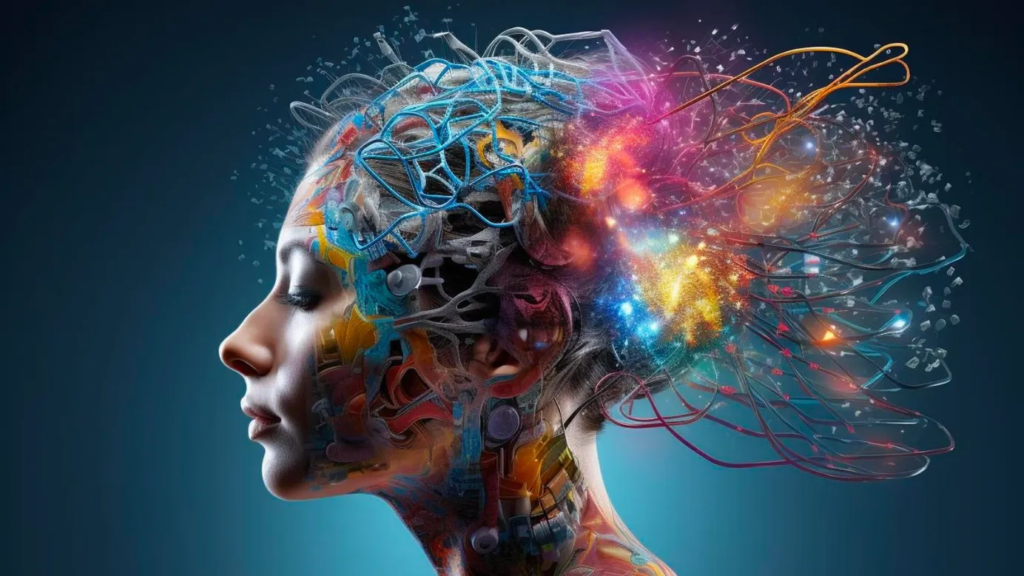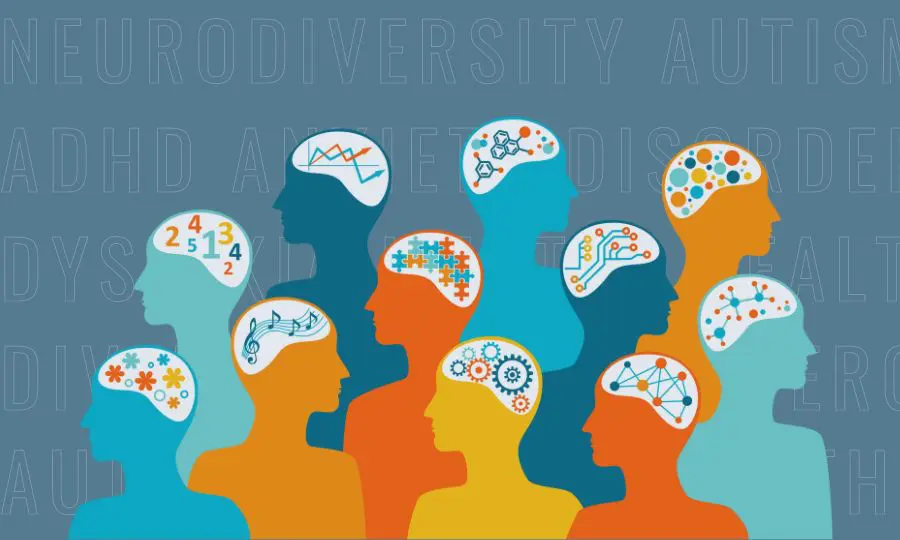In a world increasingly focused on uniformity, celebrating neurodiversity emerges as a vital conversation about mental health and resilience. It’s a journey beyond labels, toward embracing the unique wiring of our brains and building a more inclusive society.
For far too long, diagnoses like autism, ADHD, dyslexia, and others have been viewed as limitations. Yet, neurodiversity reframes these differences as valuable facets of human experience, recognizing the strengths and diverse perspectives they offer. Just as fingerprints distinguish individuals, our brains also exhibit a spectrum of neurotypes, each contributing to the rich tapestry of human thought and behavior.
Understanding Neurodiversity:
At its core, neurodiversity acknowledges that brains aren’t cookie-cutter models. They’re like vibrant landscapes shaped by unique experiences, genetic predispositions, and neural pathways. This diversity manifests in countless ways, influencing how we think, learn, interact, and experience the world.
Think of it like this:
Some minds are like powerful searchlights, illuminating specific details with laser-like focus. They excel at deep analysis, meticulous attention to detail, and problem-solving in highly structured environments.
Others are like kaleidoscopes, bursting with creativity and divergent thinking. They thrive in unstructured environments, generating innovative ideas and seeing connections where others might miss them.
Some navigate the world through a symphony of senses, acutely aware of every nuance in their surroundings. They may be hypersensitive to sound, light, touch, or taste, finding beauty and inspiration in the sensory tapestry of life.
Others crave a constant hum of stimulation, their minds buzzing with internal energy. They may fidget, pace, or seek out intense experiences to feel fully engaged and present.
These are just a few examples, and the spectrum of neurodiversity is far richer and more varied than any analogy can capture. The key takeaway is that these variations are not deficiencies or weaknesses, simply different ways of being. Each neurodiverse brain offers a unique perspective and set of strengths, enriching the tapestry of human experience.
Why Does Understanding Matter?
The benefits of embracing neurodiversity go far beyond mere acceptance – they have the power to propel society forward. When we break free from rigid notions of “normal” and embrace the beauty of different minds, we unlock a treasure trove of potential:
Innovation Engine:
Neurodivergent individuals often possess exceptional abilities in pattern recognition, creative problem-solving, and divergent thinking. Their minds don’t get bogged down by conventional limitations, allowing them to tackle challenges from fresh angles and breakthrough stagnant thinking. Remember Alan Turing, the father of computer science, who was also neurodivergent and whose groundbreaking ideas revolutionized technology.
Their unique perspectives can lead to game-changing discoveries and inventions. For example, Temple Grandin, a renowned animal scientist with autism, revolutionized livestock handling practices by applying her sensory sensitivities to understand animal behavior better.
Building a Flourishing Community:
Embracing neurodiversity nurtures a culture of inclusion and belonging, where everyone feels valued and respected for their unique contributions. It allows neurodivergent individuals to thrive without the burden of masking or hiding their true selves, leading to increased mental health and well-being.
It creates a rich tapestry of diverse perspectives and experiences, enriching our communities and broadening our understanding of the world. Imagine classrooms where dyslexic students are celebrated for their creative thinking, and autistic students are valued for their meticulous attention to detail and passion for specific interests.
Unleashing Untapped Potential:
Understanding neurodiversity helps us identify and remove the barriers that often hinder neurodivergent individuals from reaching their full potential. By providing appropriate support and accommodations, we empower them to overcome challenges and excel in their chosen fields.
It can lead to a more diverse and vibrant workforce, where every individual’s strengths and talents are recognized and nurtured. Companies that embrace neurodiversity are proven to be more innovative, adaptable, and competitive in the global marketplace.
Understanding the Spectrum: A Symphony of Strengths and Challenges

Neurodiversity’s symphony plays out in countless ways, with each individual bringing their unique melody to the ensemble. Here’s a deeper dive into some common variations, celebrating their strengths while acknowledging their challenges:
Autism Spectrum Disorder (ASD):
Strengths: ASD often grants laser-like focus, meticulous attention to detail, and unparalleled dedication to their passions. They can be masterful pattern recognizers, find connections others miss, and exhibit remarkable creativity in areas like music, art, or technology.
Challenges: Social communication can be a hurdle, with difficulties reading nonverbal cues and understanding sarcasm. Sensory sensitivities can be overwhelming, making loud noises or bright lights uncomfortable or even debilitating.
Attention Deficit Hyperactivity Disorder (ADHD):
Strengths: ADHD brains buzz with boundless energy and enthusiasm. They often possess remarkable creativity, generating innovative ideas and tackling problems with unconventional approaches. Their adaptability and quick thinking excel in fast-paced environments.
Challenges: Focusing on one task can be a struggle, leading to distractibility and difficulty with organization. Impulsivity can sometimes lead to hasty decisions or unintended consequences.
Dyslexia:
Strengths: Visual-spatial skills often shine in dyslexic individuals, giving them a unique perspective on design, geometry, or architecture. They may excel in creative problem-solving tasks and possess strong verbal comprehension skills.
Challenges: Reading and writing can be challenging, with difficulties in letter recognition, spelling, and decoding text. It can impact academic performance and require different learning strategies.
Beyond the Labels:
Remember, these are just a few notes in the vast symphony of neurodiversity. Each individual’s experience is unique, and focusing solely on labels can limit our understanding. Instead, let’s appreciate the strengths and challenges woven into each melody, offering support and accommodations where needed.
Moving Forward:
Embracing neurodiversity is not just about understanding differences; it’s about valuing them. By celebrating the unique strengths and contributions of every individual, we create a richer, more vibrant world where everyone can flourish. Imagine a classroom where students with dyslexia design innovative learning models, where individuals with ADHD lead brainstorming sessions with their boundless energy, and where individuals with ASD contribute their meticulous focus to complex research projects.
Supporting Neurodiversity: From Understanding to Action
Building a supportive world for neurodivergent individuals requires going beyond mere awareness and into action. It’s about actively nurturing an environment where their differences are not just recognized but embraced and empowered. Here are some key ways to turn understanding into tangible support:
1. Cultivating Empathy and Open Communication:
Create safe spaces for open dialogue and self-advocacy. Encourage neurodivergent individuals to share their experiences and needs without fear of judgment or misunderstanding.
Actively listen with empathy and a willingness to learn. Take the time to understand unique perspectives and challenges, avoiding preconceived notions or assumptions.
Educate yourself and others. Seek out reliable resources and engage in open discussions about neurodiversity to dispel myths and promote understanding.
2. Building Accessible Environments:
Promote sensory-friendly spaces. Provide designated areas with low noise, dimmed lighting, and fidgets to help manage sensory overload.
Offer flexible learning and working styles. Recognize that different learning styles exist and consider alternative approaches, such as visual aids, hands-on activities, or extended deadlines.
Advocate for inclusive technology. Ensure access to assistive technology tools and software that can adapt to diverse needs and learning styles.
3. Celebrating Strengths and Talents:
Shift the focus from challenges to capabilities. Highlight the unique strengths and talents each neurodivergent individual possesses, be it exceptional attention to detail, creative problem-solving skills, or unwavering dedication.
Create opportunities for their strengths to shine. Design projects and tasks that leverage their natural abilities and empower them to excel in their preferred ways.
Challenge the “one size fits all” approach. Recognize that individual strengths and talents manifest differently, and tailor assessments and opportunities accordingly.
4. Combating Stigma and Misinformation:
Engage in active outreach and awareness campaigns. Educate colleagues, community members, and the general public about neurodiversity and the importance of inclusion.
Challenge stereotypes and misinformation. Speak up against prejudice and discrimination based on neurodiversity, advocating for accurate representation and respect.
Promote positive narratives and celebrate successful individuals. Highlight the achievements and contributions of neurodivergent individuals in various fields, showcasing their strengths and inspiring others.
5. Providing Targeted Mental Health Resources:
Recognize the unique mental health needs of different neurotypes. Different conditions may be associated with specific anxieties, challenges, or vulnerabilities.
Provide access to tailored mental health support. Partner with mental health professionals trained in understanding and addressing the needs of neurodivergent individuals.
Create support groups and peer networks. Encourage peer-to-peer support and connection, nurturing a sense of belonging and shared understanding.
Resilience Through Acceptance:
Embracing neurodiversity is a journey, not a destination. It can be fraught with hurdles and frustrations, especially in a world often built for a singular neurotype. Navigating social interactions, educational systems, and everyday tasks can feel like playing a different game with different rules. This disconnect can lead to feelings of isolation, misunderstanding, and even self-doubt.
However, acceptance and support pave the way for resilience. When individuals feel their unique neurotype is valued and understood, they can tap into their inherent strengths and build mental resilience to overcome challenges.
Remember, resilience is not about becoming “normal” or fitting into a rigid mold. It’s about embracing your unique neurotype, leveraging its strengths, and navigating challenges with confidence. By nurturing a culture of acceptance and understanding, we can create a world where neurodiversity is not just tolerated, but celebrated, allowing every individual to compose their symphony of resilience.


